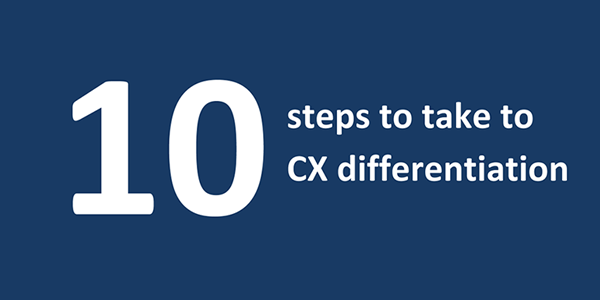Taking the 10 steps to CX differentiation

Do you really know what your customers think of the experience your business is delivering? At this year’s Gartner Customer Experience & Technologies Summit , analyst Ed Thompson explained that there is often a wide gap between what consumers expect and what companies are delivering.
For example research from Bain found that while 80% of CEOs felt their firm was delivering a superior experience, only 8% of their customers agreed. That’s an enormous difference.
Why is the gap developing? The truth is that today’s consumers have higher expectations, complain more, are less loyal, and voice their opinions more frequently. While they expect their experience to be optimized and personalized at the same time they demand privacy. This all contributes to the customer experience gap, between what companies deliver and what customers expect, which can put downward pressure on loyalty and sales. Research suggests it can even have an impact on earnings and stock price.
The burden is therefore on CX leaders to overcome the challenges of meeting customer expectations through a combination of superior management of people and technology, while at the same time keeping senior company executives in the loop. How can they do this? Here’s a summary of the 10 step model that Thompson recommends:
1 Build the team
Customer experience is an all-encompassing challenge that involves many parts of the organization. Which means CX leaders typically have a large number of people directly and indirectly reporting to them, from multiple departments. So one of the initial tasks is to ensure that everyone is working together, to a clear purpose and plan, while eliminating silos.
2 Audit existing projects
Thompson outlines seven types of CX projects from collecting feedback and analyzing customer processes, to increasing accessibility and enabling personalization. All of these matter, so as a CX leader you should review all of your current projects to see which category they come under and how they rank among current priorities.
3 Consolidate Voice of the Customer
It is essential for the head of CX to bring together all sources of customer feedback, whether it is direct from the customer (complaints, surveys or forums), indirect (social media or email) conversations or inferred (from talking to customer facing staff or analyzing website journeys). This should be an ongoing commitment to improving the company’s understanding, identifying short and long term trends as well as fixing immediate problems
4 Choose the right measurement metrics
Companies typically have around 50 CX metrics that they measure, ranging from employee engagement (such as absenteeism and satisfaction), through quality (product returns or delivery timeliness) and customer loyalty KPIs to measures of brand reputation or advocacy. The aim should be to choose metrics that fit your objectives and work together to give you an accurate picture of overall CX performance.
5 Map the customer journey
Focus on understanding and analyzing the eight cycles or phases of the customer journey identified by Gartner. How can this model – which includes phases such as ‘awareness’, ‘evaluate’, ‘purchase’, ‘use’ and ‘renew’ – be applied to map the customer journey for your specific industry? Where can you improve and where should you devote effort and resources?
6 Do the basics first
Before you look to delight customers, make sure you have got the basics right. Are you meeting their immediate expectations and if not, fix this before you move on to anything else. And obviously focus on the most urgent requirements first. For example, Thompson gave an example of DBS, a company that operates 1,100 ATMs. It has reduced the number of times its machines run out of cash by 80%, and eliminated 30,000 hours of customer wait times, by simply improving its forecasting analytics.
7 Set executive aspirations
Make sure executives know this is a long-term journey – it may start with quick wins, but improvements are likely to plateau over time. And while some improvements might result in an immediate large return, other phases might produce smaller incremental gains. Business leaders need to understand this.
8 Steal from the best
Customers compare the CX you deliver to every other business they deal with – irrespective of industry. Which means you need to be constantly assessing what others are doing well and working out how to incorporate their most successful initiatives into your own CX strategy. Don’t just focus on the best in your industry, look in other sectors. And it’s not just about the big things, but smaller areas too. Has a successful brand in an unrelated sector found a clever way to handle customer returns or to stop customers switching channels, for example?
9 Motivate the many
You need to ensure everyone in the organization is fully sold on the customer CX agenda and motivated to make it a reality. This is about creating a fully customer-centric culture, and involves changing attitudes, which can take time. Thompson advises using a combination four important levers to create this kind of shift: explain, participate, incentivize and coerce.
10 Send ambassadors out
Reinforce your successes and become widely known for your CX. Tell the world about what you are doing by entering awards, getting your people to speak at events and engage in networking. Not only will this boost your brand awareness, but it will introduce you to other successful businesses that your firm can learn from. You should try to incorporate external ideas as well as developing initiatives internally. The job is never done, so keep learning and improving.
Following these ten steps will not only help you bridge the CX gap, but also enable you to differentiate your organization, boosting loyalty and ultimately revenues.







Comments